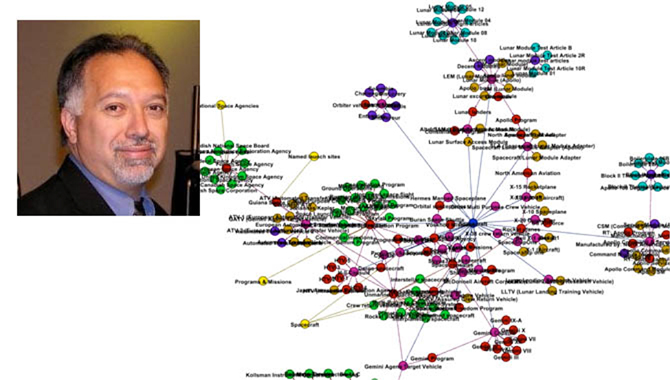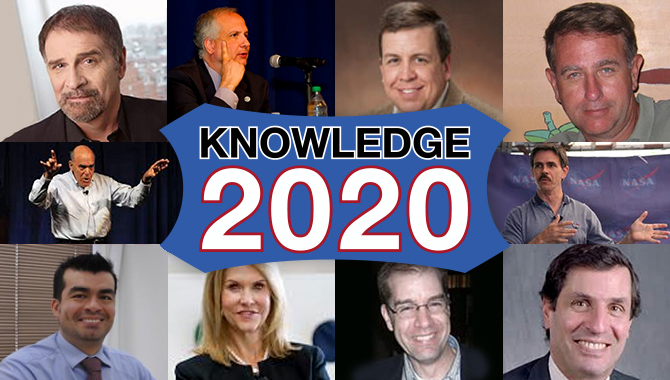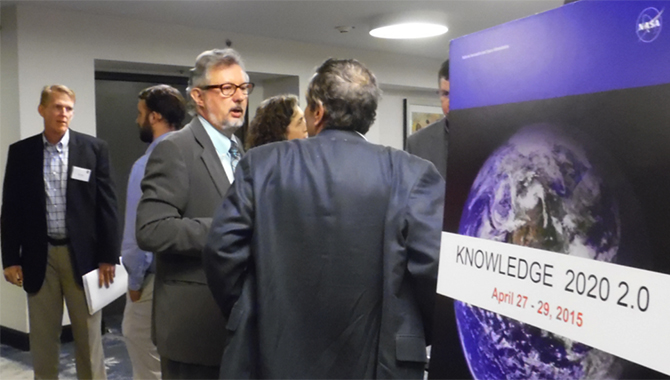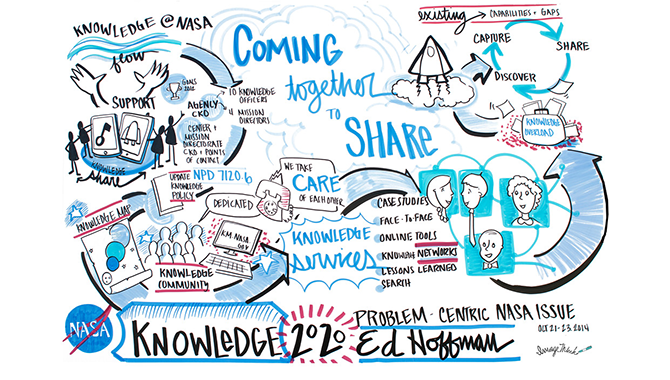
David Meza and a cluster of “Spacecraft” search.
Image Credit: NASA / JSC Office of the Chief Knowledge Officer
When NASA Chief Knowledge Officer (CKO) Ed Hoffman travels to NASA centers in support of APPEL project management and engineering courses, he often partners with the local CKO to facilitate a segment on finding knowledge at NASA. During those discussions, they’ve uncovered one of the biggest challenges for practitioners. When asked where they go to find knowledge to solve problems on projects, even knowledge that should be discoverable on the nasa.gov sites, class participants typically respond “I google it.” Moreover, if they continue to talk about search, they typically talk about the disappointment even with google.
Even a center with a very mature google-Search appliance like JSC has found that when users are surveyed, most people still can’t find what they need, or they don’t get the data in a way that is easily useable.
Sometimes the question becomes: if even the most well-known search tool doesn’t give NASA users the knowledge they need to reduce risk and enhance project success, what will?
That’s the question that a cross-agency search CIO and Knowledge Services working group, led by JSC’s Operational Excellence Program lead, David Meza, is attempting to answer.
With more than 20 years of service at Johnson Space Center (JSC), David has responsibility for the continual improvement of methodologies and measures. For the last two years, he has developed and implemented various tools and techniques to facilitate process improvement, including work in knowledge management and Search.
Meza discusses some of his work in knowledge management and search for JSC and the Agency.
Question: What are some of the challenges within your organization when it comes to knowledge management and search?
Answer: First of all, it is really trying to understand what type of data and the criticality of that data that we have within our repositories, within our projects and programs. Is it just simple vendor data or is it risk analysis that needs to be tagged for future use? We also have some issues and concerns with just being able to find the data in our repositories. Is the data accessible to the right people and can it be found in a timely manner? Can we get the data to be found in the first two or three results from a Search query?
Question: What are two of the successful knowledge efforts you are involved in at NASA?
Answer: We have several successful projects that we continue to work on. The big project we are working on is—in collaboration with the OCIO, Agency Chief Knowledge Officer and the other Centers’ CKOs—developing a knowledge management working group across the Agency to develop requirements for designing the KM community’s search infrastructure. In collaboration, my JSC team is exploring methodologies that will allow us to increase our accessibly and the visibility of our critical data. We are taking a look at several different types of Search and exploration methods to understand their capabilities so we can improve upon search, such as a Semantic Search, where we look at the context of the word. For example, if someone is looking for information on Mercury, that could be Mercury the element, Mercury the spaceship, or Mercury the planet. By these contextual or semantic technologies, we can help the search interface better understand what the user is asking for based on the other words close to the word ‘Mercury’ and get them to the right information faster.
Question: You have written and lectured on faceted Search… is that another type of Search?
Answer: We are also looking an incorporating Faceted Search, where the user may not know exactly what they are looking for, but they can be given a group of terms. For example, Amazon will give you a group of terms, such as “LCD” or “Plasma” or other terms, when you look for a television. We can offer similar faceted search for certain keywords. We are also exploring other methodologies such as computational and cognitive. Much like you can ask Siri a question and get an answer back, we are looking at using natural language queries, when a person can either ask verbal or can type and get an answer back based on a computational algorithm interface. If I ask the question, “Where is the ISS right now?” then the computational algorithm will understand that ISS most likely means International Space Station and will look at the user’s relative location—through IP address or GPS or mobile device—and give you the coordinates.
Question: You are also an expert on topic modeling… is that another effort?
Answer: Yes, another effort is Topic Modeling: to look at our lessons learned databases, where we have a huge amount of information scattered around but the common problem I hear from users is that is it difficult to use or even find the information they need. Our theory here is that in part by using various topic modelling algorithms we can takes these lessons learned and combined them into high level topics. We did an analysis of our lessons learned out of the NASA Engineering Network (NEN) database, and were able to break them down into 15 different topics—ranging anywhere from project-program-oriented to hardware-software issues to safety issues to mission issues to budget issues—so somebody can now look at different topics that interest them. We can also correlate these documents to each other to show similar documents related to documents already viewed. Being able to correlate similar documents together will make it easier for a user to jump from one topic to another without having to do multiple searches.
Question: What knowledge efforts outside of your organization—but within NASA—are particularly remarkable or innovative?
Answer: I’ve been very impressed with some of the work of the Jet Propulsion Lab (JPL) within their own enterprise search requirements as well as some of the ways JPL has looked at mining their unstructured data—by unstructured data, I mean textual data, reports, information not organized in a pre-defined manner such as information you find in a database.
Question: JPL’s David Oberhettinger just spoke at the Federal Knowledge Management Community about another innovation at JPL…
Answer: The JPL video work—“JPLTube”—through MAVIS (Microsoft audio video indexing system) is also highly intriguing, from two perspective, one is the aspect of a user being able to go to a precise point in a video through search, and the other is the mining capabilities of interfacing what JPL has been able to extract with latent semantic analysis or topic modeling against their scripts scraped from the video transcript. Which means, of course, doesn’t require a human watching the video and writing down the Search terms at any given point – the technology does that as the video is being recorded. There is a lot of good work at JPL.
Question: You mentioned the NEN lessons learned database…
Answer: Of course, the NEN has always done a great amount of work within the engineering world with their lessons learned databases, their community of practice, available and promoted, to get communities of experts and those interested together, a huge benefit to NASA: people across NASA can find someone who is already an expert in a topic of interest to them and to get help. This reduces project time and program time.
Question: What do you think is the biggest misunderstanding people have about knowledge management?
Answer: From a management perspective, the biggest misconception is that people look at KM as “past” knowledge; the management of knowledge is only attributed to knowledge that has already happened. I think people need to know that we need to manage our knowledge dynamically, that is, now, in the present as it is being created, to utilize it for the future, to our benefit. Too many people look at knowledge management as data capture and data storage. There is a lot more to KM. There is the manipulation of knowledge, there is turning implicit knowledge to explicit. There is also the presentation layer.
Question: How important is presentation?
Answer: As far as a mature model for knowledge management community, you have to have an excellent way of presenting that knowledge to your users that is readable to them. Since we have such a diverse, varied community, not one type of presentation is useful for everybody. You are going to have multiple ways of presenting that information, some kind of business intelligence platform is essential.
Question: In one of your presentation on Big Data, you used the metaphor of Dante’s Inferno.
Answer: Yep, it is a Divine Comedy, a journey through Inferno, Purgatorio and, we are convinced, ending in Paradiso. That’s how we feel about the Search journey at NASA.
Learn more about Johnson Space Center’s Chief Knowledge Office and Search:
JSC Knowledge Online (JKO) (NASA Only)
JSC Semantic System including the taxonomy, ontology and term metadata library to enhance JSC Search (NASA Only)








